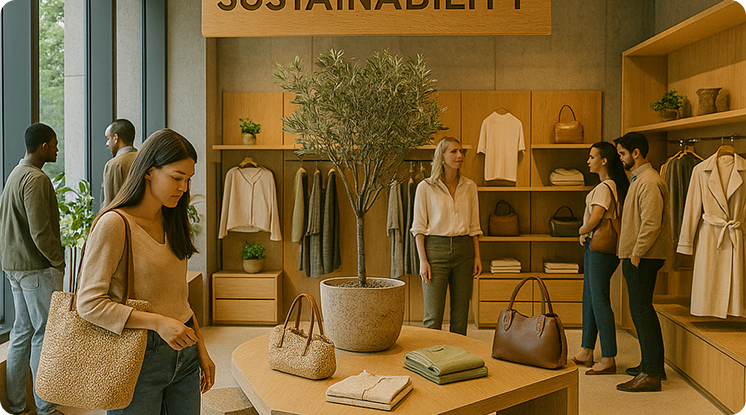
Sustainability:
The New Language Luxury
Sustainability:
The New Language Luxury

Luxury used to mean excess glossy packaging, heavy marble floors, and golden accents. But in 2025, luxury speaks a different language. One that whispers of conscience, craftsmanship, and care for the planet.
Sustainability has become the new luxury. Not because it’s trendy, but because today’s discerning customers see responsibility as refinement. For them, authenticity and integrity feel rarer and therefore more premium than any shiny façade.
Take Patagonia. Their stores not only sell jackets, but they also repair them. They resell pre-loved gear. They proudly tell customers: “Don’t buy this jacket unless you need it.” The result? Stronger loyalty, stronger sales, and an aura of authenticity that money can’t buy.
Or look at IKEA’s Vienna flagship. A green façade of 160 trees, no parking spaces, a rooftop park, a furniture store reimagined as an urban oasis. That’s luxury today: a space designed not just for shopping, but for breathing, lingering, and living better.
Even Adidas in Delhi built sustainability into its flagship DNA floors made of upcycled carbon tiles, zones showcasing recycled plastic innovations, and digital storytelling around their “End Plastic Waste” mission.
What’s striking is that none of this looks like sacrifice. Quite the opposite. The stores feel modern, minimalist, and aspirational. Sustainability is framed not as a compromise, but as sophistication.
We believe design has the power to elevate responsibility into desire. A reclaimed wood table can be more beautiful than a synthetic one. A minimalist, uncluttered store can feel more premium than a gilded one. A visible repair station can be more impressive than a hidden backroom.
Because in the end, sustainability isn’t a marketing checkbox. It’s a new form of storytelling. One where luxury is measured not by how much a brand flaunts, but by how deeply it cares.
Luxury used to mean excess glossy packaging, heavy marble floors, and golden accents. But in 2025, luxury speaks a different language. One that whispers of conscience, craftsmanship, and care for the planet.
Sustainability has become the new luxury. Not because it’s trendy, but because today’s discerning customers see responsibility as refinement. For them, authenticity and integrity feel rarer and therefore more premium than any shiny façade.
Take Patagonia. Their stores not only sell jackets, but they also repair them. They resell pre-loved gear. They proudly tell customers: “Don’t buy this jacket unless you need it.” The result? Stronger loyalty, stronger sales, and an aura of authenticity that money can’t buy.
Or look at IKEA’s Vienna flagship. A green façade of 160 trees, no parking spaces, a rooftop park, a furniture store reimagined as an urban oasis. That’s luxury today: a space designed not just for shopping, but for breathing, lingering, and living better.
Even Adidas in Delhi built sustainability into its flagship DNA floors made of upcycled carbon tiles, zones showcasing recycled plastic innovations, and digital storytelling around their “End Plastic Waste” mission.
What’s striking is that none of this looks like sacrifice. Quite the opposite. The stores feel modern, minimalist, and aspirational. Sustainability is framed not as a compromise, but as sophistication.
We believe design has the power to elevate responsibility into desire. A reclaimed wood table can be more beautiful than a synthetic one. A minimalist, uncluttered store can feel more premium than a gilded one. A visible repair station can be more impressive than a hidden backroom.
Because in the end, sustainability isn’t a marketing checkbox. It’s a new form of storytelling. One where luxury is measured not by how much a brand flaunts, but by how deeply it cares.
